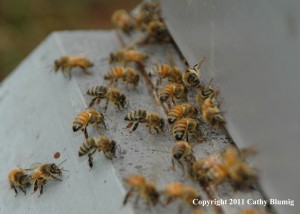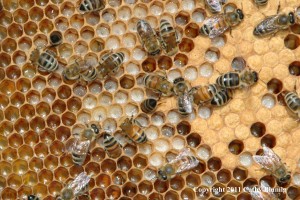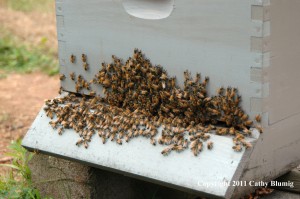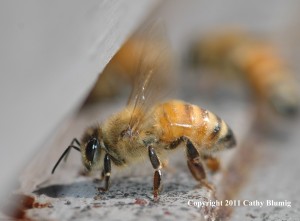Like the rest of New Jersey, the weather has been extra hot and muggy the last few days at Wolgast Tree Farm. The searing heat and humidity has not only altered our behavior (we’ve been getting up at 4:45 am to work on our Christmas trees until 8:30 am), but also the behavior of our honeybees.
The temperature and humidity within a honeybee hive influences the development of bee brood (baby bees still in the comb) and the making of honey. Beehives aren’t outfitted with electric fans or air conditioners, but they have other ways of controlling the temperature and humidity within their home.
When it’s hot and humid, bees can be seen outside the hive facing the entrance and fanning their wings.  Positioned in this way honeybees are able to use their wings to draw warm air out of the hive. Usually there are bees on the inside of the hive on the bottom board that are also fanning, but they are out of sight unless you were able to kneel down in front of the entrance and used a flashlight to look inside.
Positioned in this way honeybees are able to use their wings to draw warm air out of the hive. Usually there are bees on the inside of the hive on the bottom board that are also fanning, but they are out of sight unless you were able to kneel down in front of the entrance and used a flashlight to look inside.
Circulating the air inside the hive by fanning keeps the level of carbon dioxide and other harmful gases from building up, and keeps the hive’s humidity at 50%. It also helps prevent beeswax from melting and removes excess water from nectar that was collected by the bees to help make honey.
Fanning also causes water that honeybees have gathered and placed in empty cells within the comb to evaporate which will cool and ventilate the hive. When it gets extremely hot honeybees collect more water than they do pollen or nectar from flowers. This is to prevent temperatures in the hive from getting so high that it would kill bee brood. The average lifespan of a worker honeybee during the summer is six weeks. Dead brood means no adult bees are coming along to replace those that die after six weeks. This would eventually lead to the  death of the entire colony, so the bees do whatever it takes to keep the brood alive. This is a picture of a frame from one of our hives that contains different stages of brood development. There is capped brood (the tan covering over the round cells that is mostly to the right of the picture), bee larva (white “C” shaped, grub-like brood in the uncovered cells mostly in the center of the picture) and to the left of the larva are honeybee eggs, which look like very tiny white grains of rice at the bottom of the cells (click on the photo to enlarge it). Having different ages of brood and eggs means an ongoing supply of adult bees for the future.
death of the entire colony, so the bees do whatever it takes to keep the brood alive. This is a picture of a frame from one of our hives that contains different stages of brood development. There is capped brood (the tan covering over the round cells that is mostly to the right of the picture), bee larva (white “C” shaped, grub-like brood in the uncovered cells mostly in the center of the picture) and to the left of the larva are honeybee eggs, which look like very tiny white grains of rice at the bottom of the cells (click on the photo to enlarge it). Having different ages of brood and eggs means an ongoing supply of adult bees for the future.
Another way that honeybees try to control the temperature inside the hive is by “bearding”.  This is when bees gather on the outside of the hive in order to reduce the hive’s temperature and congestion. This activity is usually seen during late afternoon.
This is when bees gather on the outside of the hive in order to reduce the hive’s temperature and congestion. This activity is usually seen during late afternoon.
We are constantly amazed at how the 30,000 honeybees that live in a hive are able to work together and do what needs to be done, when it needs to be done, in order for the hive to survive.  Whether they are foraging among numerous flower sources in search of different types of nectar and pollen, or gathering water and fanning their wings to control the temperature within their hive, honeybees are wonders of nature and a special part of Wolgast Tree Farm.
Whether they are foraging among numerous flower sources in search of different types of nectar and pollen, or gathering water and fanning their wings to control the temperature within their hive, honeybees are wonders of nature and a special part of Wolgast Tree Farm.
Speak Your Mind
You must be logged in to post a comment.